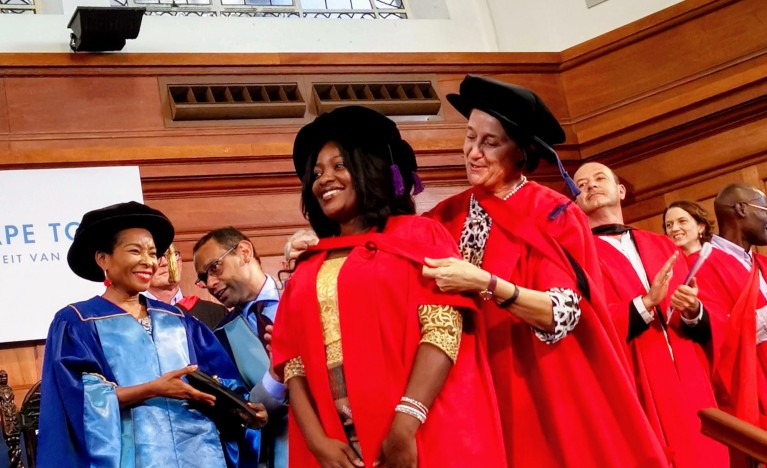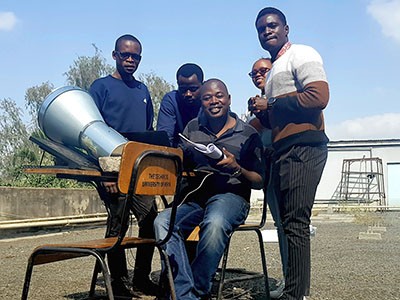
Brenda Namumba, shown receiving her PhD, would not have switched from teaching in a secondary school to become an astronomer without the scholarships and encouragement she received. Credit: Brenda Namumba
I only found out about astronomy back in 2009, as an undergraduate studying physics, when I happened to attend an international conference on space science and astronomy at the University of Zambia in Lusaka. That was the first time I heard about young people studying space science and astronomy at the master’s or PhD level. Back then, I had not even met anyone from Zambia doing a master’s in physics.
At the meeting, I interacted with established scholars and graduate students, who told me about their research and what they wanted to do in future. We kept in touch and some of them helped me to apply for scholarships and explained how to write a personal statement.

‘I didn’t know someone could pursue astronomy as a career’
The conference made me decide to further my studies, and I applied for many scholarships while working as a secondary-school physics and mathematics teacher. Eventually, in 2012, I was accepted into South Africa’s National Astrophysics and Space Science Programme (NASSP) as an honours undergraduate student at the University of Cape Town (UCT). This scholarship programme, established in 2003, has supported more than 300 honours-degree students and more than 140 master’s candidates.
Diverse astronomy
The programme introduced me to the idea that astronomers can make use of a range of electromagnetic wavelengths. In 2012, there was a lot of talk about the exciting science that was going to happen with the SKA. That was the year when it was decided to split the telescope between South Africa and Australia. South Africa had built the 7-dish KAT-7 radio telescope, which was the test bed for its 64-dish MeerKAT radio telescope that will eventually form part of the SKA. I wanted to be at the forefront of answering some of the interesting questions that these radio instruments would make it possible to tackle.
One topic in particular caught my attention. During my honour’s degree, I took a course in extragalactic astronomy in which the lecturer (who later became my PhD supervisor) talked about dwarf galaxies. At the time, they hadn’t been explored in much detail with optical telescopes because they are faint and difficult to detect, and the situation was even worse at radio wavelengths. But, the new generation of instruments, such as KAT-7, was better suited to exploring their structure and properties to understand galaxy evolution. The South African Radio Astronomy Observatory (SARAO) funded my master’s degree at the University of KwaZulu-Natal in Durban in 2013, my doctorate at the UCT in 2015, and then my first postdoc at Rhodes University in Makhanda from 2019 to 2022.
The power of networks
SARAO gave me this great opportunity, and it wasn’t solely about my academic qualifications. I’ve been able to attend conferences around the world, which have given me a different mindset concerning how people do research, and also confidence in presenting my work. For example, at the SARAO Postgraduate and Postdoctoral Research Conference, the organizers, who include SARAO staff and researchers from universities across South Africa, guide us in how to present our work and interact with colleagues and experts.


